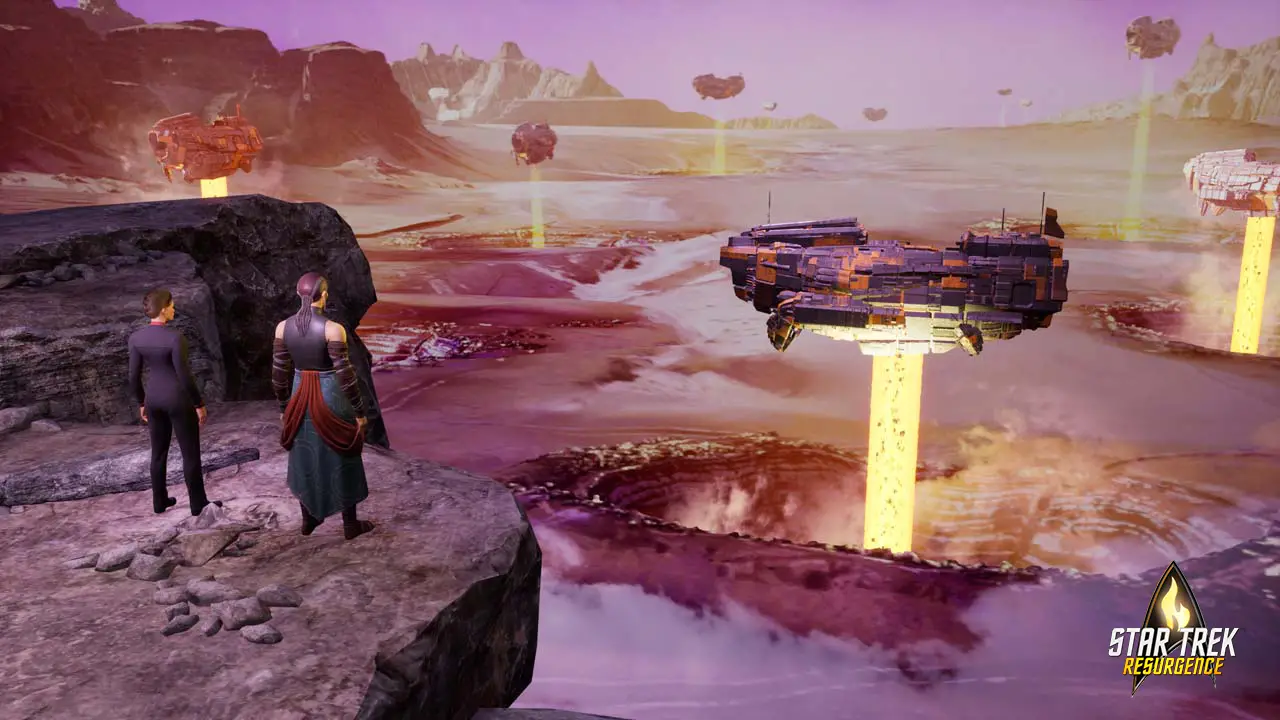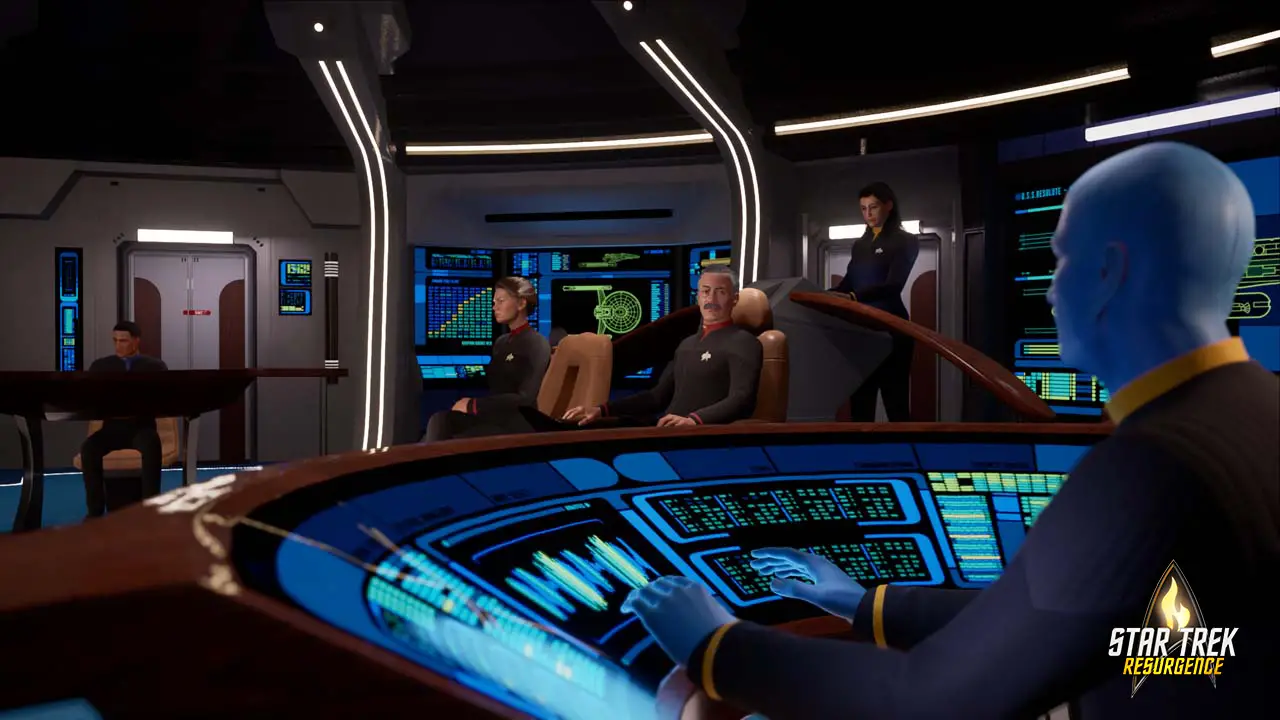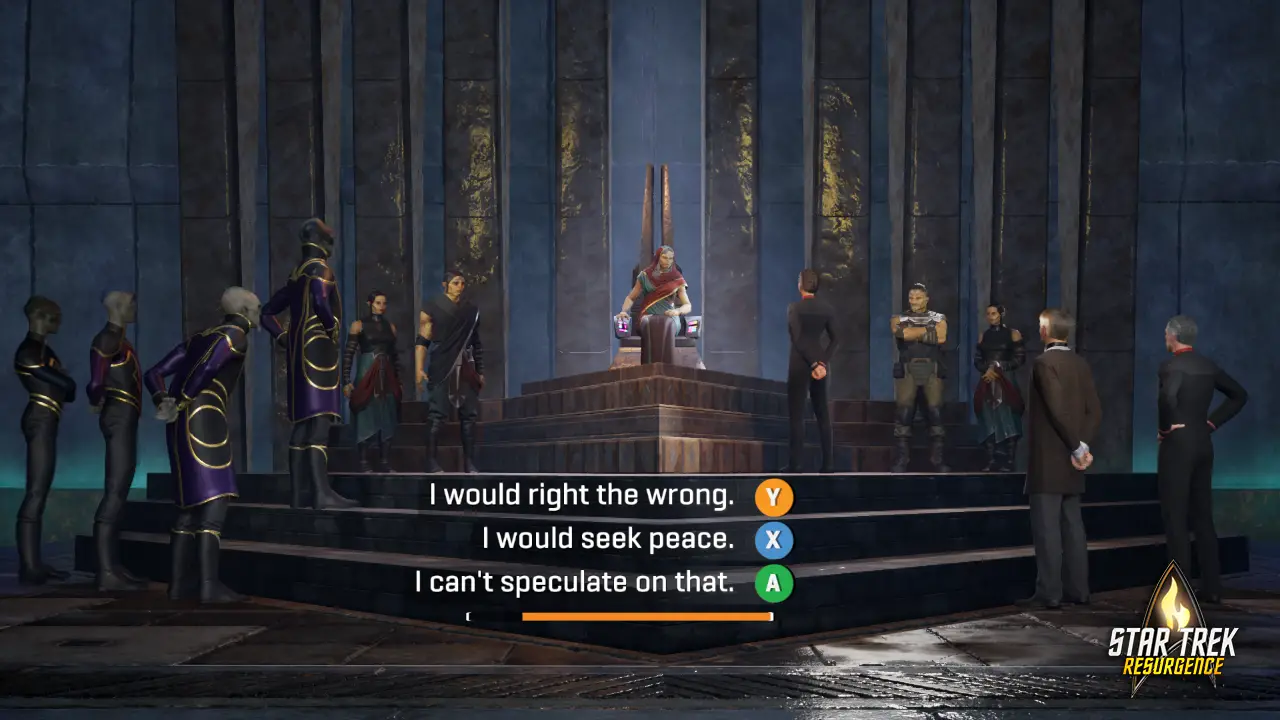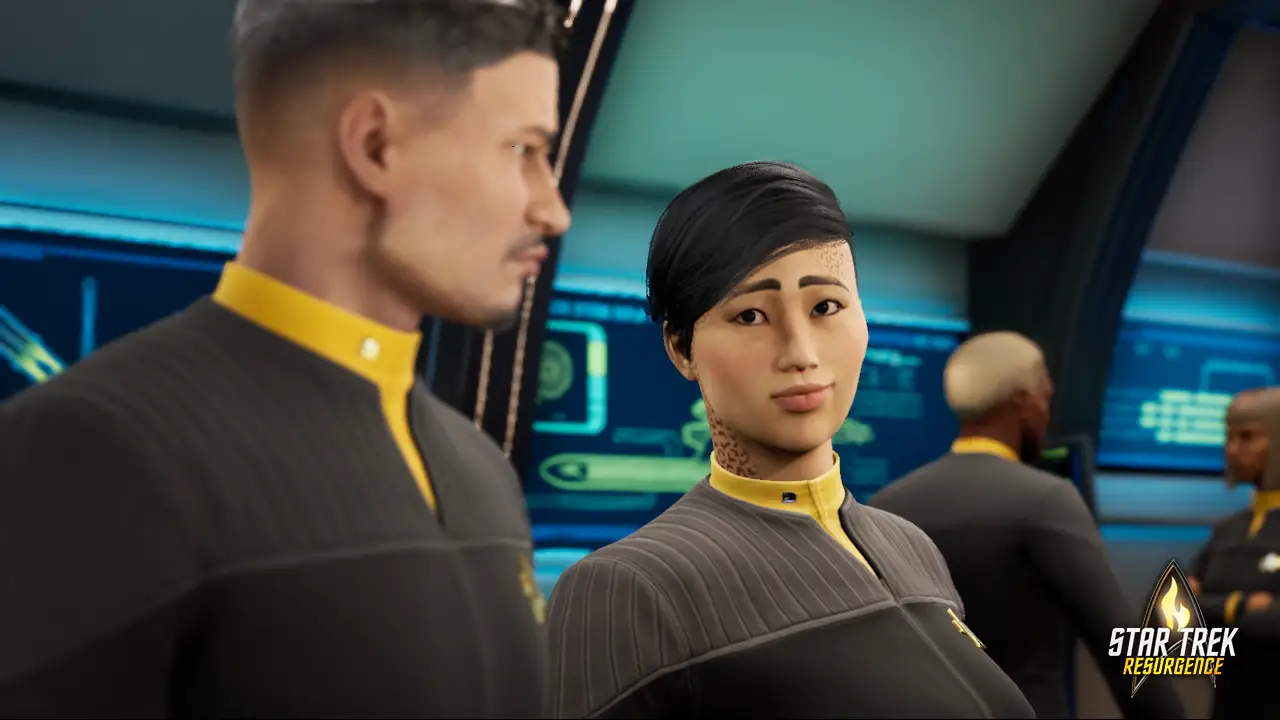
Recently, we had the honor to interview Dan Martin and Andrew Grant, writers for Star Trek: Resurgence, about their new game and what their process looked like overall. As a long-time Star Trek fan, it was really exciting to hear about their own fandom and how that played into how they handled such an iconic IP. Take a look at what they had to say:
Adam Moreno: Hello and welcome back to our “We Interview” series here on gamingtrend.com. Today, we’re talking to the writing team from Star Trek: Resurgence. You’ve probably played some of their work before Batman: The Enemy Within, Game of Thrones, The Walking Dead, The Wolf Among Us, and more! Dramatic Labs writers, Dan Martin and Andrew Grant. How are you two doing today?
Dan Martin: Great. Thanks for having us.
Andrew Grant: Yeah, doing great! Thank you.

Adam Moreno: Very excited to talk to you guys. We said a little bit earlier, I am a Trek fan. You see a lot of Star Wars behind me, but my parents did raise me as a Trek fan as well as a Star Wars fan. So yeah, let’s get into it. You all have written for many games now that rely on a narrative; where the player controls the ending by making choices throughout the game. How has your previous work maybe inspired the direction that you guys went with Star Trek: Resurgence?
Dan Martin: You know, we think of it as a continuation and evolution of what we’ve done before. We’ve changed the format a bit. It’s one epic tale told across roughly 10-ish hours as opposed to releasing it episodically, which was great for us because we got to, you know, write the whole thing. See the whole thing. And then look back at where it starts and fine tune it across the whole story, which you don’t really get to do when the first episode is out the door and you’re still trying to finish it. But you know, in a lot of ways, Star Trek; it worked the other way. Star Trek inspired a lot of what we did before because it’s such a great model for tough moral and ethical choices and, you know, going back to the original series. Kirk, Spock, and McCoy were this great triumvirate of decision making where Spock and McCoy would pull Kirk in different directions. And you know, there was no right or wrong answer and that’s the thing that we always like to do is put you in a place where it’s not like, there’s an obvious, “well, this is the way to go and I’m gonna get, you know, I’m gonna get points for doing this one, and I’m gonna lose points for doing that one.” It’s really about putting the player in control and letting them decide what’s right for them.
Andrew Grant: And we always felt like it was the perfect fit of format and franchise because there are so many shades of gray in Star Trek, and that’s something that we always loved. And we came at it as fans and rather than do sort of like the sort of great “greatest hits medley” of themes and nostalgia from that era, we, from the very beginning, set out to create a story that would stand on its own. That would be the equivalent of a full season of a show, or maybe even like a full feature length. Playable movie experience, but the difference is that you’re making the choices, you’re shaping the experience for yourself, and for a fan, and we all came at it as huge fans, you’re immersed in this world. You’re interacting with Spock. You’re interacting with Riker. Those aren’t spoilers because they’re in trailers. You can, you know, you’re exploring the bridge like it’s just super fun.

Adam Moreno: That’s wonderful. And Speaking of being fans, you guys have a history of working with IP’s with extremely loyal fan bases such as Batman, Game of Thrones, Walking Dead and now Star Trek. Was there stress about “will the fans like this?” How do you handle that with your writing process? Cause a lot of these fans are, you know, you have to be on it. You have to. You have to know your Star Trek history, otherwise they’ll, they’ll tell you.
Dan Martin: Well, I mean, with any franchise that we’ve worked on before, you have to approach it professionally to some degree and do market research and see what people think about it out there. But for Star Trek, a huge part of our approach was just, “what do we want?” Because we are fans. For me, Star Trek: The Next Generation was my first appointment. Doing at 7:00 PM on Saturdays, at the top of the UHF dial channel 56 in Massachusetts. And you know, that was kind of our guiding principle, which makes it a lot more fun. It also puts a lot of responsibility on you when it’s something you love. You want to get it right. But I think that that was to our benefit in the end. And, you know, I’ve watched all of the series multiple times. I know a lot of people on the crew had, so we had our own sort of backlog of information and expertise already. And then we had a great partnership with Paramount and CBS where, if there’s something we couldn’t find or figure out, you know, they had their own experts that we could tap into as well.
Adam Moreno: Wow, that’s awesome.
Andrew Grant: Yeah, the brain-trust at Paramount was really helpful in terms of guiding us because there are so many concurrent stories being told across so many different formats in the Star Trek universe. And so, we wanted to carve out our own space, which informs some of our creative choices so that you don’t feel bound necessarily by canonical events and you could really shape that experience.

Adam Moreno: Well, Speaking of the narrative aspects of things, when working with two lead characters, how early in the process did you decide, “we’re gonna have two different characters that they can play as, these are the choices we’re gonna make.” And how did that maybe change the process of the writing angle once you realize, “we’re not just going to have one character that they’re playing, we’re going to have two and they’re going to be completely different.”
Dan Martin: Well, it was an early decision that we made and we had done this kind of thing in previous games that we worked on. Game of Thrones, which Andrew and I both worked on, used five playable characters. I think it was. So we knew early on that we wanted to do that. It opens up some storytelling opportunities because you can tell one chunk with one POV, and then leave a bit of a cliffhanger, and then go to the other one and it kind of propels the player through the story. Wanting to always get back to that other story. But by the end of the other chapter, you hope that they want to get back to that one. So it’s just like a page turning novel hopefully and also it’s just there’s so much to this world and so much to being in Starfleet that we wanted to make. We showed both the side of the bridge and the other side of it, the side that you don’t get to see that much, the lower decks, and you know the show and the episode of TNG lower decks, those are both ensigns, we go even further we, go with the enlisted crew.
Andrew Grant: And we knew early on that we wanted to explore the lower decks, that was a given. And then of course, you’re making more diplomatic decisions and more sort of pressure packed decisions on the bridge. But by the same token, you know Carter. Our playable character. He has some hefty choices to make throughout the narrative, but what’s nice is that it organically created sort of an A and B storyline so that you could hand off from one POV to the other, and it would feel sort of like the show where and I’m dovetailing back to see what’s happening in this other area of the of the story.
Adam Moreno: Something that I noticed was people really did appreciate the writing being very fluid going from one character to another and I know that that could be very, very difficult to get correct. So kudos to you guys for working so hard and your fandom really seems to come through with just the feeling of it being Star Trek.
Dan Martin: And we you know, we want to also point out that, like the cinematics team did a great job of figuring out the ways in some cases when going back and forth more quickly, it becomes more and more difficult to make those transitions. And they really studied the look of Star Trek across all eras, going back to the motion picture with leaving space dock and then sort of – The, you know, syndicated weekly television of The Next Generation through Star Trek: First Contact for big budget Hollywood look and even the more recent iterations.

Adam Moreno: Now, this is our last question. I’ve appreciated all of your answers so much, but we always ask the same question. What is one memory of your time in gaming that will live for you guys forever as a happy memory? Your work on games, anything in the gaming realm that really just made you happy? And it’s gonna always be in your memory.
Dan Martin: Ohh, well then I have to go with something working on this project which was directing Jonathan Frakes as the voice of Riker in this game. As a fan of Star Trek, you know, he’s certainly particularly Next Generation. He was a huge figure and also Jonathan Frakes’ behind the camera is so important that just to be involved with him and have him bring that authenticity and genuine Star Trek to our game was huge, so that was a pinch me moment. Actually, my first job in Hollywood, I worked in the Roddenberry building on the Paramount lot, so it’s very much a full circle experience for me here.
Adam Moreno: Did you have to calm your nerves before talking to him for the first time? Because I feel like that’s something that I would have trouble with.
Dan Martin: I think before we got started, certainly. But then once he was set up in the voice booth it was time to go to work. And what would, what would a Starfleet officer do? They they’d put it aside and they’d go to work.
Adam Moreno: How about you, Andrew? What’s one memory that you’ll always remember?
Andrew Grant: What stands out for me is something… I came out of the film industry, which of course is a linear narrative, and you write something and it disappears into the ether and you hope someday it gets made. But what I’m reminded of lately, watching people play through the game, is that, it’s just a unique experience when you’re watching someone on Twitch or on YouTube playing through the game. In these moments that you hope are going to land and to see their like real time reaction to these moments, that it’s like, “ohh, it landed. It resonated, just so gratifying.” It’s so unique to our medium and so that whole process has been really rewarding for us writers. And for the whole team, because the fan response has been phenomenal.
Adam Moreno: So you guys have actively watched other people play this game like on Twitch. That’s phenomenal! I won’t tell anybody. I think that’s a lovely thing to do. And I love the excitement that you guys got from their excitement.
Well, thank you guys so much for your time. We appreciate both Dan and Andrew giving us some great answers and we’ll have all of the links to. Purchase Star Trek: Resurgence in the link below. Thank you guys!
Andrew Grant: Thanks for having us!
